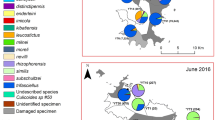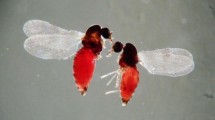Abstract
Culicoides vectors are critical to the survival and transmission of bluetongue virus as infection only occurs in areas or regions where competent vectors are present. The success of Culicoides biting midges as vectors is mainly related to their vast population sizes and to their means of dispersal. Their choice of host for blood feeding is sparsely described. The aim of the present study was to establish methods for the identification of bloodmeal hosts and determine the identity and diversity of bloodmeals of vertebrate hosts from wild-caught biting midges near livestock farms. The study includes some of the most common and abundant species of biting midges in Denmark: Culicoides obsoletus, Culicoides scoticus, Culicoides pulicaris and Culicoides punctatus. We collected 8,378 biting midges including nine species of Culicoides of which blood-fed specimens were found from six species. We identified 251 blood engorged biting midges, and hosts were identified in 115 of 125 analysed specimens (90%). Cow, roe deer, horse, mallard and wood pigeon were identified as hosts. The most abundant host species was cow, which constituted 73.9% of the total identified bloodmeals, but the common wood pigeon was found with a frequency as high as 18.3%. In conclusion, the molecular methods applied were proven useful in identifying bloodmeal hosts from different Culicoides species. The results indicate that Culicoides species are opportunistic in their choice of bloodmeal host with a preference for cattle when present, which is important to have in mind for epidemiologist when making predictive models. Accordingly, the results of this study will add useful parameters for modelling bluetongue virus transmission and in the development of veterinary contingency plans.
Similar content being viewed by others
References
Alcaide M, Rico C, Ruiz S, Soriguer R, Muñoz J, Figuerola J (2009) Disentangling vector-borne transmission networks: a universal DNA barcoding method to identify vertebrate hosts from arthropod bloodmeals. PLoS ONE 4(9):e7092. doi:10.1371/journal.pone.0007092
Bartsch S, Bauer B, Wiemann A, Clausen P-H, Steuber S (2009) Feeding patterns of biting midges of the Culicoides obsoletus and Culicoides pulicaris groups on selected farms in Brandenburg, Germany. Parasitol Res 105:373–380
Blackwell A, Mordue (Luntz) AJ, Mordue W (1994) Identification of bloodmeals of the Scottish biting midge, Culicoides impunctatus, by indirect enzyme-linked immunosorbent assay (ELISA). Med Vet Entomol 8:20–24
Cêtre-Sossah C, Baldet DJ-C, Mathieu B, Perrin A, Grillet C, Albina E (2004) Molecular detection of Culicoides spp. and Culicoides imicola, the principal vector of bluetongue (BT) and African horse sickness (AHS) in Africa and Europe. Vet Res 35:325–337
Cicero C, Johnson NK (2001) Higher-level phylogeny of New World vireos (Aves: Vireonidae) based on sequences of multiple mitochondrial DNA genes. Mol Phylogenet Evol 20:27–40
Frost SW (1957) The Pennsylvania insect light trap. J Econ Entomol 50:287–292
Goffredo M, Romeo G, Monaco F, Di Gennaro A, Savini G (2004) Laboratory survival and blood feeding response of wild-caught Culicoides obsoletus complex (Diptera: Ceratopogonidae) through natural and artificial membranes. Vet Ital 40:282–285
Hajibabei M, Singer GAC, Hebert PDN, Hickey DA (2007) DNA barcoding: how it complements taxonomy, molecular phylogenetics and population genetics. Trends Genet 23:167–172
Hollingsworth JP, Hartsock JG, Stanley JM (1963) Electric insect traps for survey purposes. United States Dept. of Agriculture, ARS. pp. 42–31
Imura T, Sato Y, Ejiri H, Tamada A, Iswa H, Sawabe K, Omori S, Murata K, Yukawa M (2010) Molecular identification of blood source animals from black flies (Diptera: Simuliidae) collected in the alpine regions of Japan. Parasitol Res 106:543–547
Kent RJ (2009) Molecular methods for arthropod bloodmeal identification and applications to ecological and vector-borne disease studies. Mol Ecol Resour 9:4–18
Kent RJ, Norris DE (2005) Identification of mammalian blood meals in mosquitoes by a multiplexed polymerase chain reaction targeting cytochrome b. Am J Trop Med Hyg 73:336–342
Lane N (2009) On the origin of barcodes. Nature 462:272–274
Lysyk TJ, Danyk T (2007) Effect of temperature on life history parameters of adult Culicoides sonorensis (Diptera: Ceratopogonidae) in relation to geographic origin and vectorial capacity for bluetongue virus. J Med Entomol 44:741–751
Maan S, Rao S, Maan NS, Anthony SJ, Attoui H, Samuel AR, Mertens PPC (2007) Rapid cDNA synthesis and sequencing techniques for the genetic study of bluetongue and other dsRNA viruses. J Virol Meth 143:132–139
MacLachlan NJ (2004) Bluetongue: pathogenesis and duration of viraemia. Vet Ital 40:462–467
Mehlhorn H, Walldorf V, Klimpel S, Schmahl G (2008) Outbreak of bluetongue disease (BTD) in Germany and the danger for Europe. Parasitol Res 103(Suppl 1):79–86
Meiswinkel R, Goffredo M, Dikstra EGM, van der Ven IJK, Baldet T, Elbers A (2008) Endophily in Culicoides associated with BTV-infected cattle in the province of Limburg, south-eastern Netherlands, 2006. Prev Vet Med 87:182–195
Molaei G, Andreadis TG (2006) Identification of avian- and mammalian-derived bloodmeals in Aedes vexans and Culiseta melanura (Diptera: Culicidae) and its implication for West Nile virus in Connecticut, U.S.A. J Med Entomol 43:1088–1093
Molaei G, Andreadis TG, Armstrong PM, Anderson JF, Vossbrinck CR (2006) Host feeding patterns of Culex mosquitoes and West Nile virus transmission, northeastern United States. Emerg Infect Dis 12:468–474
Molaei G, Andreadis TG, Armstrong PM, Bueno R, Dennett JA, Real SV, Sargent C, Bala A, Randle Y, Guzman H, da Rosa AT, Wuithiranyagool T, Tesh RB (2007) Host feeding pattern of Culex quinquefasciatus (Diptera: Culicidae) and its role in transmission of West Nile virus in Harris County, Texas. Am J Trop Med Hyg 77:73–81
Molaei G, Andreadis TG, Armstrong PH, Diuk-Wasser M (2008) Host-feeding patterns of potential mosquito vectors in Connecticut, USA: molecular analysis of bloodmeals from 23 species of Aedes, Anopheles, Culex, Coquillettidia, Psorophora, and Uranotaenia. J Med Entomol 45:1143–1151
Molaei G, Farajollahi A, Armstrong PM, Oliver J, Howard JJ, Andreadis TG (2009) Identification of bloodmeals in Anopheles quadrimaculatus and Anopheles punctipennis from eastern equine encephalitis virus foci in northeastern U.S.A. Med Vet Entomol 23:350–356
Mullens BA, Gerry AC, Lysyk TJ, Schmidtmann ET (2004) Environmental effects on vector competence and virogenesis of bluetongue virus in Culicoides: interpreting laboratory data in a field context. Vet Ital 40:160–166
Nielsen SA, Kristensen M (2009) Danish Culicoides species of the obsoletus-group identified by morphological methods. http://medreonet.cirad.fr//FichiersComplementaires/5_Nielsen_MorphoIdentificationDanishAvaritia.pdf
Ngo KA, Kramer LD (2003) Identification of mosquito bloodmeals using polymerase chain reaction (PCR) with order-specific primers. Entomol Soc Am 40:215–222
Petersen FT, Nielsen SA (2001) “Ceratopogonidae” In: Petersen FT, Meier R (eds) A preliminary list of the Diptera of Denmark. Steenstrupia 26:119–276
Saegerman C, Berkvens D, Mellor PS (2008) Bluetongue epidemiology in the European Union. Emerg Infect Dis 14:539–544
Simon C, Frati F, Beckenbach A, Crespi B, Lui H, Flook P (1994) Evolution, weighing and phylogenetic unity of mitochondrial gene sequences and a compilation of conserved polymerase chain reaction primers. Ann Entomol Soc Am 8:651–701
Sternberg Lewerin S, Hallgren G, Mieziewska K, Treiberg Berndtsson L, Chirico J, Elvander M (2010) Infection with bluetongue virus serotype 8 in Sweden in 2008. Vet Rec 167:165–170
Townzen JS, Brower AVZ, Judd DD (2008) Identification of mosquito bloodmeals using mitochondrial cytochrome oxidase subunit I and cytochrome b gene sequences. Med Vet Entomol 22:386–393
Acknowledgement
The project was supported by the Danish Ministry of Food, Agriculture and Fisheries. We thank an anonymous reviewer for many helpful suggestions.
Author information
Authors and Affiliations
Corresponding author
Rights and permissions
About this article
Cite this article
Lassen, S.B., Nielsen, S.A., Skovgård, H. et al. Molecular identification of bloodmeals from biting midges (Diptera: Ceratopogonidae: Culicoides Latreille) in Denmark. Parasitol Res 108, 823–829 (2011). https://doi.org/10.1007/s00436-010-2123-4
Received:
Accepted:
Published:
Issue Date:
DOI: https://doi.org/10.1007/s00436-010-2123-4




